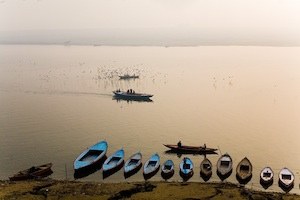Transboundary River Basins: Status and Trends
 Volume 3 presents the results of the first global assessment of transboundary river basins, prepared in partnership with UNEP-DHI (lead), the International Union for the Conservation of Nature, the Stockholm International Water Institute, Oregon State University, The City University of New York Environmental CrossRoads Initiative, the International Geosphere-Biosphere Programme, Columbia University Center for International Earth Science Information Network, the Delta Alliance, and the University of Kassel Center for Environmental Systems Research. This assessment aims to be of use to a broad variety of stakeholders, including transboundary institutions of specific water systems (e.g. river-basin organizations, bi-national and inter-State Commissions), national institutions and governments, regional and international agencies and donors.
Volume 3 presents the results of the first global assessment of transboundary river basins, prepared in partnership with UNEP-DHI (lead), the International Union for the Conservation of Nature, the Stockholm International Water Institute, Oregon State University, The City University of New York Environmental CrossRoads Initiative, the International Geosphere-Biosphere Programme, Columbia University Center for International Earth Science Information Network, the Delta Alliance, and the University of Kassel Center for Environmental Systems Research. This assessment aims to be of use to a broad variety of stakeholders, including transboundary institutions of specific water systems (e.g. river-basin organizations, bi-national and inter-State Commissions), national institutions and governments, regional and international agencies and donors.
The report is being released following the entry into force of the UN International Watercourses Convention (2014), providing a solid baseline for this Convention and for international and regional institutions with an interest in water and food security. It is also designed to be relevant to groups of countries managing shared resources, and to individual countries to broaden their understanding of the current situation and future outlook. The state of water resources in any location depends on a complex array of natural circumstances, stressors and management responses. Measuring differences within each basin involves assessment of the transboundary nature of the issues and links between locations. In this assessment, the transboundary nature of basins has been highlighted through the use of Basin Country Unis (BCUs) – the portions of each basin belonging to the respective country – and for deltas through delta country units (DCUs).
Using BCUs (and DCUs) helps to show how each country contributes to the overall picture of risk in a given basin. It also illustrates that basin-wide problems and solutions in transboundary basins are often directly linked to individual countries. Thus, this BCU approach contributes to identifying countries that may need to be proactive or may need more assistance to solve problems that have transboundary implications. For both individual indicators and for combinations of indicators, this assessment provides a global perspective of the magnitudes of risk, a framework for comparative analysis of risks among basins, and identification of basins most and least at risk. Overall, this provides a context for policy responses at global and regional levels but also at the basin and country levels, and facilitates inter-basin learning. TWAP River Basin results can also be used in combination with detailed studies on individual basins.
The Transboundary River Basins Assessment is an indicator-based assessment, which identifies and classifies river basins at risk from a variety of issues, encourages knowledge exchange, and increases awareness of the importance and state of transboundary waters. As activities in river basins often affect their deltas, 26 deltas have also been assessed. 15 core indicators across five thematic groups are assessed. Projections are made for five of these indicators and linkage indicators cover lakes and deltas.
Key Messages : Transboundary River Basins
1. The threat to freshwater biodiversity is global. Extinction risk is moderate to very high in 70% of the area of transboundary river basins. However, local-level, tailored solutions are needed to address species extinction risks.
2. The construction of dams and water diversions is in progress or planned in many transboundary river basins, often without adequate international water cooperation instruments. While many transboundary agreements exist, more effort is needed to update them to reflect modern principles of transboundary water management, such as the obligation not to cause significant harm and the principles of cooperation and information exchange.
3. Risks are projected to increase in the next 15-30 years, particularly for four hotspot regions: the Middle East, Central Asia, the Ganges-Brahmaputra-Meghna basin, and the Orange and Limpopo basins in Southern Africa. Action should be taken now to reduce future costs and impacts.
Partners
The TWAP RB component is coordinated by UNEP-DHI, with support from International Union for Conservation of Nature (IUCN) and Stockholm International Water Institute (SIWI).
Other partners include The City University of New York (CUNY), International Geosphere-Biosphere Programme (IGBP), Center for International Earth Science Information Network at Columbia University (CIESIN), Oregon State University (OSU), Center for Environmental Systems Research at the University of Kassel (CESR) and Delta Alliance (DA).
For more information on the TWAP RB go to: http://twap-rivers.org/. The TWAP RB website contains information on the assessment indicators, methodology and consortium partners. You will also find the link to the TWAP RB interactive data portal with preliminary assessment results for viewing and download.
Photo credit: pireteparrot on Flickr
 |  |  |  |  |  |  |  |
|---|







